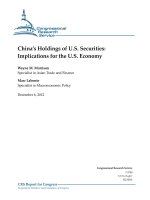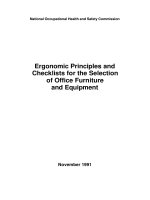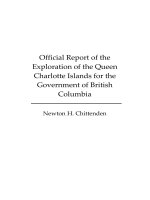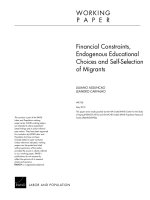Selection of Thermotropic Liquid Crystalline Polymers for Rotational Molding
Bạn đang xem bản rút gọn của tài liệu. Xem và tải ngay bản đầy đủ của tài liệu tại đây (7.95 MB, 400 trang )
Selection of Thermotropic Liquid Crystalline Polymers for
Rotational Molding
Eric Scribben
Dissertation submitted to the Faculty of
Virginia Polytechnic Institute and State University
in partial fulfillment of the requirements for the degree of
DOCTOR OF PHILOSOPHY
in
Chemical Engineering
Dr. Donald G. Baird, Chairman
Dr. Richey M. Davis
Dr. Garth L. Wilkes
Dr. Peter Wapperom
Dr. Scott Case
Dr. Martin Rogers
July 19, 2004
Blacksburg, Va
Keywords: rotational molding, TLCP, coalescence, sintering
Selection of Thermotropic Liquid Crystalline Polymers for
Rotational Molding
Eric Scribben
(ABSTRACT)
Thermotropic liquid crystalline polymers (TLCPs) possess a number of physical
and mechanical properties such as: excellent chemical resistance, low permeability, low
coefficient of thermal expansion, high tensile strength and modulus, and good impact
resistance, which make them desirable for use in the storage of cryogenic fluids.
Rotational molding was selected as the processing method for these containers because it
is
convenient
for
manufacturing
large
storage
vessels
from
thermoplastics.
Unfortunately, there are no reports of successful TLCP rotational molding in the
technical literature. The only related work reported involved the static coalescence of
two TLCP powders, where three key results were reported that were expected to present
problems that preclude the rotational molding process.
The first result was that
conventional grinding methods produced powders that were composed of high aspect
ratio particles. Secondly, coalescence was observed to be either slow or incomplete and
speculated that the observed difficulties with coalescence may be due to large values of
the shear viscosity at low deformation rates. Finally, complete densification was not
observed for the high aspect ratio particles. However, the nature of these problems were
not evaluated to determine if they did, in fact, create processing difficulties for rotational
molding or if it was possible to develop solutions to the problems to achieve successful
rotational molding.
This work is concerned with developing a resin selection method to identify
viable TLCP candidates and establish processing conditions for successful rotational
molding.
This was accomplished by individually investigating each of the
phenomenological steps of rotational molding to determine the requirements for
acceptable performance in, or successful completion of, each step. The fundamental
steps were: the characteristics and behavior of the powder in solids flow, the coalescence
behavior of isolated particles, and the coalescence behavior of the bulk powder. The
conditions identified in each step were then evaluated in a single-axis, laboratory scale,
rotational molding unit.
Finally, the rotationally molded product was evaluated by
measuring several physical and mechanical properties to establish the effectiveness of the
selection method.
In addition to the development and verification of the proposed TLCP selection
method, several significant results that pertain to the storage of cryogenic fluids were
identified as the result of this work. The first, and argueably the most significant, was
that the selection method led to the successful extension of the rotational molding process
to include TLCPs. Also, the established mechanical properties were found to be similar
to rotationally molded flexible chain polymers. The biaxial rotationally molded container
was capable of performing to the specified requirements for cryogenic storage: withstand
pressures up to 34 psi at both cryogenic and room temperatures, retain nitrogen as a gas
and as a cryogenic liquid, the mechanical preform retaining nitrogen, as both a gas and as
a cryogenic liquid, and resist the development of micro-cracks during thermal cycling to
cryogenic conditions.
iii
Acknowledgements
The author wishes to express his thanks to Professor Donald G. Baird for the
support and guidance that resulted in the completion of this work. In addition, the author
would also like to thank each member of his research committee (past and present): Dr.
Davis, Dr. Loos, Dr. Rogers, Dr. Wapperom, and Dr. Wilkes.
The author would also wish to acknowledge the following persons:
His parents and brother for their continuous support throughout this process.
John D. Souder for guidance and the infinite wisdom in initiating interest in
engineering and polymer processing.
Professor Kurt Koelling and all of the members of CAPCE at The Ohio State
University for encouragement to pursue a graduate degree.
Vladimir Kogan and all of the members of the Aerosol Science group at Battelle
Memorial Institute for their direction and inspiration to pursue a graduate degree.
All current and past members of the Polymer Processing Lab that he had the
opportunity to serve with: Phil, Mike, Wade, Matt, Quang, Brent, Chris, and
Aaron.
Those members of the department staff who have made this work easier over the
years: Diane, Chris, Riley, Wendell, and Mike.
The group of Buckeyes that have demonstrated unwaivering support throughout
this process.
The following friends for supplying adequate distraction from his research
project: Brooks, John & Jen, Maatha, Doug, Mary, Corey, and too many others to
list.
iv
Original Contributions
The following are considered to be significant original contributions of this research:
1. A clearer understanding of the effect of viscoelasticity on polymer coalescence.
Representation of the transient rheological response in the coalescence model is
essential to predicting the coalescence rates for polymeric materials at times that are
less than their characteristic relaxation times. Incorporating the transient rheology
provides a qualitative picture of coalescence that is consistant with reports that
increasing the relaxation time accelerates coalescence.
2. It is demonstrated that TLCPs coalesce faster than is predicted by the Newtonian
coalescence model, which is in agreement with a viscoelastic coalescence model that
uses the transient rheology. However, TLCP coalescence rates cannot be accurately
predicted by the transient model, indicating that an anisotropic liquid crystalline
constitutive model that includes the effect of liquid crystalline structure may be
necessary to accurately model the process.
3. A novel technique is developed to produce spherical TLCP particles for use in
rotational molding.
This is used to overcome the low apparent density and
unacceptable powder flow that results when TLCPs powders are prepared by
conventional grinding methods.
v
4. A selection method is devised to identify viable TLCP candidates and establish
processing conditions for successful rotational molding. In the development of this
method several key results were established. The behavior of the shear viscosity at
low shear rates can be used to determine thermal and environmental conditions where
coalescence occurs. Densification is not possible for TLCPs in the rotational molding
process by extending the molding cycle time, as is standard practice for densifying
flexible chain polymers in rotational molding.
However, bubble entrapment is
eliminated during the neck growth process by optimizing the mold rotation rate.
vi
Table of Contents
1 Introduction
1
1.1
Thermotropic Liquid Crystalline Polymers
2
1.2
Rotational Molding
7
1.3
Polymer Sintering
10
1.4
Research Objectives
13
1.5
References
15
2 Literature Review
19
2.1
Rotational Molding
21
2.1.1
Powder Properties
21
2.1.2
Coalescence
37
2.1.3
Processing Considerations
66
2.2
Thermotropic Liquid Crystalline Polymers
76
2.2.1
Mechanical Properties
77
2.2.2
Rheology of Thermotropic Liquid Crystalline Polymers
82
2.3
Research Objectives
94
2.4
References
96
3 Experimental Methods
3.1
Materials
115
116
3.1.1
Polypropylene
117
3.1.2
Thermotropic Liquid Crystalline Polymers
117
3.2
Thermal Analysis
119
3.3
Generation and Characterization of TLCP Powders
119
3.4
Rheological Characterization
122
3.4.1
Polypropylenes
Table of Contents
122
vii
3.4.2
3.5
TLCPs
Surface Tension Measurement
123
125
3.5.1
Polypropylenes
125
3.5.2
TLCPs
126
3.6
Coalescence Experiments
128
3.7
Densification Experiments
128
3.8
Single Axis Rotational Molding
130
3.9
Mechanical and Physical Property Testing
131
3.9.1
Testing of Samples from the Densification Study
131
3.9.2
Rotationally Molded Samples
132
3.10
Biaxial Rotational Molding
133
3.11
References
135
4 The Role of Transient Rheology in Polymeric Coalescence
136
4.1
Abstract
137
4.2
Introduction
138
4.3
Experimental
145
4.3.1
Materials
145
4.3.2
Surface Tension Measurement
146
4.3.3
Rheological Characterization
147
4.3.4
Coalescence
148
Numerical Methods
150
4.4
4.4.1
Model Parameter Fitting
150
4.4.2
Solution of the Transient UCM Model
153
4.5
Results and Discussion
155
4.5.1
Newtonian and Steady State UCM Coalescence Models
155
4.5.2
Single Mode Transient UCM Model
160
4.5.3
Multimode Transient UCM Model
162
Table of Contents
viii
4.6
Conclusions
164
4.7
Acknowledgements
166
4.8
References
167
5 The Role of Transient Rheology in the Coalescence of Thermotropic
Liquid Crystalline Polymers
169
5.1
Abstract
170
5.2
Introduction
171
5.3
Experimental
174
5.3.1
Materials
174
5.3.2
Differential Scanning Calorimetry
176
5.3.3
Surface Tension Measurement
176
5.3.4
Rheological Characterization
177
5.3.5
Coalescence Experiments
179
5.4
Results and Discussion
180
5.4.1
Rheological Characterization
180
5.4.2
Experimental Coalescence
184
5.4.3
Transient UCM Coalescence Model Predictions
190
5.5
Conclusions
191
5.6
Acknowledgements
192
5.7
References
193
6 The Rotational Molding of a Thermotropic Liquid Crystalline
Polymer
195
6.1
Abstract
196
6.2
Introduction
197
6.3
Analytical Methods
201
Table of Contents
ix
6.3.1
Material
201
6.3.2
Generation and Characterization of Powders
202
6.3.3
Coalescence Experiments
205
6.3.4
Thermal Behavior
206
6.3.5
Surface Tension
207
6.3.6
Rheology
208
6.3.7
Densification Experiments
209
6.3.8
Properties of Densification Samples
211
6.3.9
Single-Axis Rotational Molding Experiments
211
6.3.10
6.4
Properties of the Rotational Molded Samples
Results and Discussion
212
213
6.4.1
Powder Flow Characteristics
213
6.4.2
Coalescence
218
6.4.3
Densification
223
6.4.4
Single Axis Rotational Molding
227
6.5
Conclusions
233
6.6
Future Work
234
6.7
Acknowledgements
234
6.8
References
235
7 Recommendations
238
Appendix A. Shear Rheological Data
242
A.1 Polypropylene (190k)
243
A.2 Polypropylene (250k)
247
A.3 Polypropylene (340k)
255
A.4 Polypropylene (580k)
263
A.5 Vectra A 950
272
Table of Contents
x
A.6 Vectra B 950
Appendix B. Surface Tension
289
296
B.1 Polypropylene (190k)
297
B.2 Polypropylene (250k)
299
B.3 Polypropylene (340k)
304
B.4 Vectra A 950
307
B.5 Vectra B 950
309
Appendix C. Coalescence
311
C.1 Polypropylene (190k)
312
C.2 Polypropylene (250k)
313
C.3 Polypropylene (340k)
314
C.4 Vectra A 950
315
C.5 Vectra B 950
317
Appendix D. Programs for Coalescence Models
319
D.1 Newtonian Coalescence Model
320
D.2 Single Mode Steady State upper convected Coalescence Model
323
D.3 Single Mode upper convected Maxwell Coalescence Model
326
D.4 Multi-Mode upper convected Maxwell Coalescence Model
330
Appendix E. Physical and Mechanical Properties
336
E.1 Apparent Density
337
E.2 Dynamic Angle of Repose
339
E.3 Average Density
340
Table of Contents
xi
E.4 Tensile Modulus
342
E.5 Tensile Strength
344
E.6 Biaxial Rotational Molded Tank
346
Appendix F. Publications
365
Sintering of Thermotropic Liquid Crystalline Polymers
366
Performance of a Rotationally Molded Thermotropic Liquid Crystalline Polymer
374
Vita
Table of Contents
382
xii
List of Figures
Figure 1.1. Friedelian Classes: a. Nematic; b. Cholesteric; c. Smectic A; d.
Discotic.
3
Figure 1.2. SEM images of ground: a. TLCP and b. HDPE
12
Figure 1.3. General three region flow curve [33]
13
Figure 2.1. Squared Egg Particle
23
Figure 2.2. Hertz and JKR Predictions
40
Figure 2.3. Shape Evolution
45
Figure 2.4. Two-Particle Sintering Models
46
Figure 2.5. Densification Kinetics
54
Figure 2.6. Rotation Axes
67
Figure 2.7. Comparison of Transient Uniaxial and Shear Viscosities [163]
85
Figure 2.8. Three-Region Flow Curve [163]
88
Figure 2.9. Shear Viscosity Temperature Dependence Near the Nematic-Isotropic
Transition
90
Figure 3.1. Chemical structure and composition of Vectra A 950 and Vectra B
950.
118
Figure 3.2. The dynamic angle of repose of a tumbling powder in steady state
flow.
122
Figure 3.3. Diagram of test fixture used to measure the burst strength.
133
Figure 4.1. Shape evolution during the coalescence of two spherical particles
140
Figure 4.2. Steady and complex shear viscosity master curves for polypropylene
at 180°C. (c) 190k, (U) 250k, () 340k. The open symbols
represent small amplitude oscillatory shear measurements; filled
symbols represent steady shear values.
148
Figure 4.3. Optical micrographs from the coalescence of 190k polypropylene
drops
149
Figure 4.4. Single mode UCM model fit to the transient shear viscosity from
stress growth experiments at 180°C.
The symbols represent the
experimental data: (c) 190k, (U) 250k, () 340k. The lines
represent the single mode UCM fits to the data.
List of Figures
151
xiii
Figure 4.5. Multimode fit to the storage and loss moduli for the 340k sample at
180°C. ({) G', (U) G". The symbols represent the experimental
data; the lines represent the multimode UCM fit to the data.
152
Figure 4.6. Experimental polypropylene coalescence data, the Newtonian, and
steady state UCM model predictions at 180°C. The symbols
represent the experimental data: (c) 190k, (U) 250k, () 340k. The
lines represent the model predictions: (—) Newtonian model, (----)
steady state UCM model. The predictions from the steady state
model obscured because they are nearly identical to the Newtonian
results.
156
Figure 4.7. 340k polypropylene coalescence data, the Newtonian, and steady state
UCM model predictions at short times. The symbols represent the
experimental data: () 340k. The lines represent the model
predictions: (—) Newtonian, steady state UCM model with (----)
λ =1.54 sec, (····) λ =200 sec, (─·─·) λ =400 sec.
157
Figure 4.8. Biaxial extension rate as predicted by the steady state UCM model
during coalescence of the 340k sample where: (—) λ =1.54 sec, (---) λ =200 sec, (····) λ =400 sec.
159
Figure 4.9. Biaxial extensional viscosity as predicted by the steady state UCM
model during coalescence of the 340k sample where: (—) represents
6ηo that is predicted for Newtonian fluids, and (----) for λ =1.54 sec,
(····) λ =200 sec, (─·─·) λ =400 sec.
160
Figure 4.10. 340k polypropylene coalescence data, the Newtonian, and transient
UCM model predictions. The symbols represent the experimental
data: () 340k. The lines represent the model predictions: (—)
Newtonian, transient UCM model with (----) λ =1.54 sec, (····)
λ =2.0 sec, (─·─·) λ =3.0 sec.
161
Figure 4.11. Transient shear viscosity at 180°C, the single mode UCM model fits,
and the multimode UCM model predictions. The symbols represent
the experimental data: (c) 190k, (U) 250k, () 340k. The lines
List of Figures
xiv
represent the models: (—) single mode fits, (····) multimode
predictions.
163
Figure 4.12. 340k polypropylene coalescence data, the Newtonian, the single
mode transient UCM model, and the multimode transient UCM
model predictions at short times. The symbols represent the
experimental data: () 340k. The lines represent the model
predictions: (—) Newtonian, (----) single mode transient UCM
model, (····) multimode transient model.
164
Figure 5.1. Schematic of the geometric evolution of two coalescing spherical
particles.
172
Figure 5.2. Chemical structure and composition of Vectra A 950 and Vectra B
950.
175
Figure 5.3. Steady and complex shear viscosity master curves for Vectra A 950
(U) and Vectra B 950 (c) at 320°C. The open symbols represent
small amplitude oscillatory shear measurements, filled symbols
represent steady shear values.
181
Figure 5.4. Steady and complex shear viscosity master curves for Vectra A 950
(U) and Vectra B 950 (c) at 330°C. The open symbols represent
small amplitude oscillatory shear measurements, filled symbols
represent steady shear values.
182
Figure 5.5. Comparison of the transient shear viscosity for Vectra A 950
measured at a shear rate of 1×10-2 sec-1 for the two different thermal
and deformation histories. The data was measured using the
prescribed pretest shear and thermal histories: (U) at 320°C and (S)
at 330°C. The samples measured without the prescribed pretest shear
and thermal histories: () at 320°C and ( ) at 330°C. The lines
represent the UCM fits to the data.
183
Figure 5.6. Optical micrographs from the coalescence experiments of Vectra B
950 at 320°C.
List of Figures
185
xv
Figure 5.7. TLCP coalescence data, where (U) represents Vectra A 950 and (c)
represents Vectra B 950. Open symbols are used for the data at
320°C and filled symbols represent the data at 330°C.
186
Figure 5.8. Vectra A 950 coalescence data at 330°C and predictions from the
Newtonian, steady state UCM, and transient UCM coalescence
models. The symbols represent the experimental data (S) and the
lines represent the coalescence model predictions: Newtonian (—),
steady state UCM (----), and the transient UCM (····).
191
Figure 6.1. Chemical structure and composition of Vectra B 950
202
Figure 6.2. The dynamic angle of repose of a tumbling powder in steady state
flow.
205
Figure 6.3. Schematic of the geometric evolution of coalescing spherical particles
during the coalescence experiments.
206
Figure 6.4. Diagram of test fixture used to measure the burst strength.
213
Figure 6.5. Cryogenically ground Vectra B 950 pellets.
214
Figure 6.6. SEM image of a facture surface of the melt blended extrudate.
216
Figure 6.7. Dynamic angle of repose of a sample from sieve number 30.
217
Figure 6.8. DSC thermogram of Vectra B 950 with the peak and end of the melt
transition represented by stars.
218
Figure 6.9. The magnitude of the complex viscosity versus frequency are
represented as { for 320°C and U for 330°C. The shear viscosity
versus shear rate is represented as z for 320°C S for 330°C, error
bars represent deviation in the measurements.
219
Figure 6.10. Transient shear viscosity from stress growth experiments at a shear
rate of 0.01 sec-1 and 320°C. The symbol { represents the test
conducted in the presence of nitrogen and U is in the presence of air.
221
Figure 6.11. Optical micrographs from the coalescence experiments of Vectra B
950 in nitrogen at 320°C.
222
Figure 6.12. Results from the coalescence experiments, where 320°C in nitrogen
is represented as {, 320°C in air is z, and 330°C in nitrogen is U.
List of Figures
223
xvi
Figure 6.13. Image of D1 tensile bar fracture surface confirming incomplete
densification.
224
Figure 6.14. Internal surface of the rotationally molded sample D4 in the 1.59 cm
diameter cylindrical mold.
228
Figure 6.15. External surface of rotationally molded sample D4, where the width
image is 50.8 mm.
229
Figure 6.16. Comparison of bubble formation in static bulk powder and in
rotational molding.
231
Figure 6.17. Exterior surface of the cylinder rotationally molded at 3 rpm, where
the width image is 50.8 mm.
List of Figures
233
xvii
List of Tables
Table 2.1 Irregular Particle Shape Measurement [24]
27
Table 2.2. Packing Fractions for Commercial Rotational Molding Powders
31
Table 2.3 Scaling Exponents According to Transport Mechanism
44
Table 2.4. McNeil Chart [2]
69
Table 2.5. Parameters Effecting Heating Time
71
Table 2.6. Comparison of Gas Transport Properties at 35°C of Vectra A900 and PAN
[162]
80
Table 3.1. Weight Average Molecular Weight, Polydispersity, and Melt Index
117
Table 3.2. Descriptions of the powder samples used in the densification study.
129
Table 4.1. Weight Average Molecular Weight, Polydispersity, and Melt Index
146
Table 4.2. Single Mode UCM Coalescence Model Parameters and Calculated Values
for the Deborah Number at 180°C.
151
Table 4.3. Multimode Upper Convected Maxwell Model Parameters at 180°C
153
Table 5.1. UCM coalescence model parameters and calculated values for the Deborah
Number.
184
Table 6.1. Descriptions of the powder samples used in the densification study.
210
Table 6.2. Apparent density of the sieved TLCP particles.
216
Table 6.3. The apparent density of the samples used in the densification study.
224
Table 6.4. Results of the density and tensile measurements for the densification study,
S3* represents the results from the extended cycle time.
225
Table 6.5. Comparison of the tensile strength and modulus of sample S3 when molded
in the presence of air.
227
Table 6.6. The average density, tensile strength, and tensile modulus from the
rotationally molded distribution D4 compared the results for the
distribution from the densification study.
List of Tables
230
xviii
1 Introduction
1 Introduction
1
1 Introduction
1.1
Thermotropic Liquid Crystalline Polymers
Liquid crystalline behavior was first discovered in 1888 when Reinitzer observed
that upon heating, cholesteryl benzoate melted to form a turbid fluid then appeared to
melt again into a transparent phase at higher temperatures [25]. The first polymeric
liquid crystal† was reported in 1937 when it was observed that above a critical
concentration the tobacco mosaic virus formed two phases, of which one was birefringent
[3]. The first synthetic polymeric system was a poly (γ-benzyl-L-glutamate) solution,
which was reported in 1950 [8]. The first thermotropic LCPs were reported in the mid
70’s [9, 12, 28]. Since then a tremendous amount of research has been done from the
quantumchemical to the macroscopic level on a great number of systems [22]. The result
is that liquid crystalline polymer science has developed into its own discipline.
Liquid crystal (LC) describes a class of materials with long-range molecular order
somewhere between the crystalline state, which exhibits three-dimensional order, and a
disordered isotropic fluid [15]. Four classes have been identified to describe LC order:
nematic, cholesteric, smectic, and discotic [11]. Nematic describes a LC phase with only
one-dimensional long range ordering; it possesses long-range orientational order
(molecular alignment) but only short-range positional order (spatial ordering) [8]. A
cholesteric is very similar to a nematic, but it is periodically twisted along the axis
perpendicular to the long-range order axis.
A smectic phase characterizes two-
†
Liquid crystal was later renamed mesomorphic phase or mesophase. Mesomorphic is defined: of
intermediate form [7]. Friedel found this more appropriate because these materials are not crystalline and
may not even be liquids, it is a stable intermediate phase existing between the liquid and crystalline states.
1 Introduction
2
dimensional order. A discotic mesophase can occur when disc-like liquid crystalline
molecules align in columns. An illustration of these structures can be found in Figure
1.1.
a.
b.
c.
d.
Figure 1.1. Friedelian Classes: a. Nematic; b. Cholesteric; c. Smectic A; d. Discotic.
Liquid crystalline order originates, in polymeric systems, from nonflexible repeat
units, called mesogenic units, with an axial ratio greater than three [8, 21]. In dilute
solution the rigid molecules are capable of random arrangement.
As concentration
increases, the molecules are forced to adopt an oriented conformation because of
1 Introduction
3
intermolecular repulsions or excluded volume interactions. Mesogenic units can be either
rod, disc, or lathe-like and may appear within the molecule backbone either randomly or
in a recurring rigid/ flexible structure. These are called main chain LCPs. The other
common type of LCP structure, side chain LCPs, occur as a rigid pendent group to a
flexible polymer backbone with orientation that can range from parallel to perpendicular
to the backbone [21]. Of course another less common possibility would be for the LCP
to contain both main chain and side chain units. This leads to a near infinite number of
possibilities ranging in structure of mesogenic group and arrangement. Most of the
property differences noted between side and main chain LCPs have been related to the
greater mobility of side chain mesogenic units as a result of increased backbone
flexibility [21].
LC order can exist in either solutions or melts. LC transition in solution is a
function of concentration and temperature and is referred to as lyotropic systems [5].
Melts, since concentration is fixed, are only temperature sensitive and are referred to as
thermotropics. The LC phase exists between the crystalline melting point, Tm (or in the
case where no crystalline state exists, the glass transition temperature, Tg), and the upper
transition temperature where the fluid reverts to an isotropic liquid, Tlc→i [20].
Unlike isotropic fluids, orientation is quantified to describe the state and dynamics
of liquid crystals. Molecules are preferentially oriented about an axis, an apolar unit
vector, n, called the director. The direction of the director is typically arbitrary but can
be uniformly aligned through imposing boundaries, applying external magnetic or
1 Introduction
4
electric fields, or inducing viscous flow [20].
Preferential orientation implies that
molecules actually possess a distribution of orientation about the director and therefore a
parameter is needed to describe that distribution. Assuming rigid rod molecules, the
order parameter tensor is defined as [7]:
1
S ij = ∫ f (ui , t ) ui u j − δ ij dui
3
(1.1)
where ui is a unit vector which describes the orientation of a rigid rod molecule, δij is the
Kronecker delta, and f(ui,t) is the orientation distribution function.
The order parameter tensor has a few properties worth noting. It is deviatoric,
therefore its trace is equal to zero and it is symmetric. Its eigenvalues or principal values
(S1, S2, S3) which define the principal axes of orientation must also add to zero. If all
three are equal then S = 0 and the material is isotropic. If two of the eigenvalues are
equal then the system is axially symmetric (as a nematic) and Sij can be represented by:
1
S ij = S n i n j − δ ij
3
(1.2)
where S is a certain scalar equivalent to the Hermans orientation function,
S=
3 cos 2 θ − 1
(1.3)
2
ni the projection of the director in the ith direction, while the brackets denote the system
average.
Values of S range between, 1 > S >
-1
/2, with the values 1, 0, and
–1
/2
representing uniaxial orientation, random orientation, and biaxial orientation.
1 Introduction
5
Valid application of a single order parameter to describe orientation requires that
the material is uniform throughout or a “monodomain” with a single director. It is
possible for elastic distortions to induce slight continuous variation in the director of
monodomain systems [7]. This director variation is typically observed in low molecular
weight materials and becomes less likely as molecular weight increases because of steric
effects [8]. As elastic distortions become more difficult, free energy increases, and
director variation becomes discontinuous, resulting in the formation of defects and
polydomain textures.
Two types of defects have been identified for nematic liquid crystalline polymers
[7]. In thick samples it is possible to observe a system of dark flexible filaments (defined
as disclinations) that correspond to lines of singularity in molecular alignment and result
in the formation of multiple domain texture. The other defect occurs when the imposed
boundary conditions are continuously degenerate (no preferred axis in the plane of the
walls). A system of singular nodes (noyaux) form on the surface and the resulting
general texture is called a Schlieren texture.
Polydomain texture and defects are important to this particular project because of
their influence on rheology.
As previously eluded to, the formation of defects is
associated with an increase in free energy.
Under quiescent conditions the system
attempts to minimize excess free energy by combining neighboring disclinations with
opposite signs thus eliminating the pair and increasing domain size [13]. However,
mechanical energy can be stored during deformation by an increase in the number of
1 Introduction
6
defects. The development of texture and orientation during deformation can change the
rheological response to imposed stresses and strains.
Liquid crystals have a number of interesting and potentially useful properties.
Optically, the material can be birefringent, although this may be limited to a local scale
[8]. There are also a few polymeric liquid crystals that show nonlinear optical behavior
[29]. Many systems have anisotropic diamagnetic and dielectric properties [20]. The
modulus is often anisotropic, dependant upon the quality of alignment [19, 26]. An
interesting rheological feature is that the nematic phase has a lower viscosity (parallel to
the director) than the isotropic phase [8]. Negative normal stresses have also been
reported for some systems when subjected to steady shear [15]. LCPs also tend to have
low partial entropy of dissolution and therefore have a relatively high resistance to
solvents [8].
Gas transport studies have revealed that they have excellent barrier
properties because of their low gas solubility in their solid state [14]. Another notable
property is that structures can be molded with extremely accurate dimensions because of
their low or negligible coefficient of thermal expansion relative to flexible chain
polymers [5]. They also exhibit high modulus, strength, and impact properties [18].
These properties can be exploited to apply LCPs in applications where flexible chain
polymers perform inadequately.
1.2
Rotational Molding
Rotational molding, also known as rotomolding, is a process used to manufacture
hollow plastic products [6].
1 Introduction
This process is comprised of several independent
7









